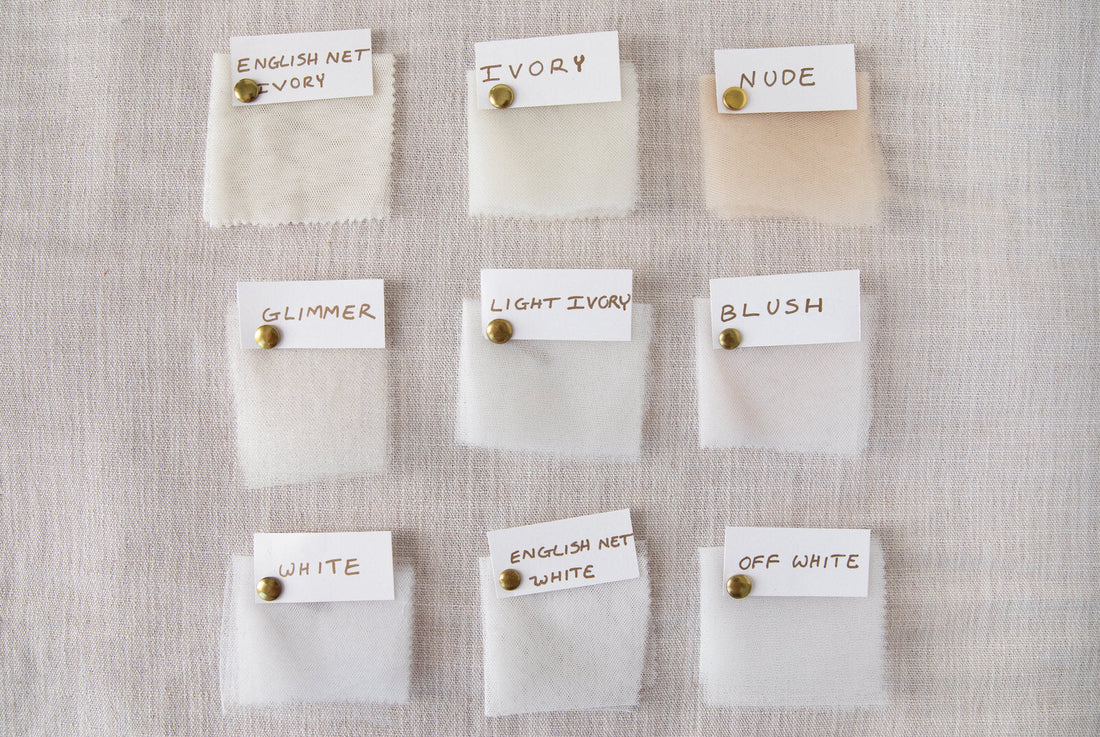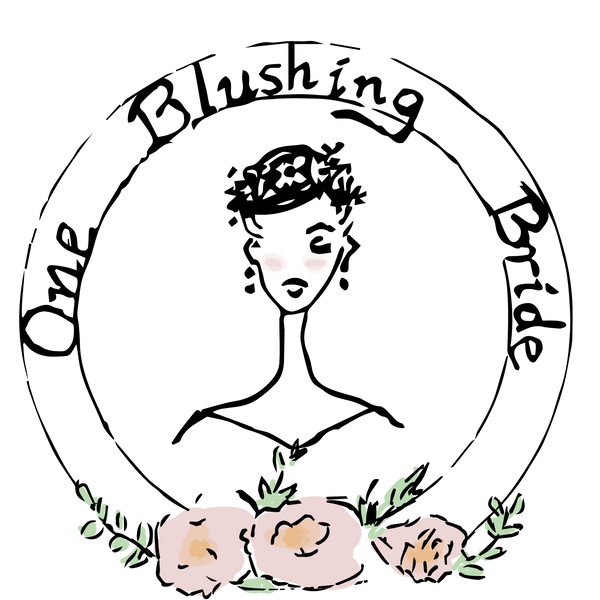
What Fabrics are Wedding Veils Made from? Tulle, English Net, & Silk
Share
What fabrics are wedding veils made of what is the right option for you and your dress? As you start to get into the nitty-gritty of color, length, trims, and fabrics, it can feel a bit overwhelming.
I am going to break down the pros and cons of the different veil fabrics so that you can decide the right fabric choice for your wedding. Regardless of your personal or bridal aesthetic, there is a veil fabric that will make you feel beautifully bridal and special.
Bonus: Make sure to request your free sample swatches if you have a few that you are interested in.
Bridal Illusion Tulle
Bridal illusion tulle is the sheer fabric that is used on almost all wedding veils.
It is softer than traditional tulle – this is not your traditional “ballerina skirt” scratchy fabric. It comes in a wide variety of colors. It’s beauty is in the ultra see-through nature, which makes it ideal for any bride who wants to wear her veil over her face. After all, we don’t want to cover up all that gorgeous make-up you had done on your special day!
Brides who suffer from headaches or migraines will appreciate how whisper-light the illusion tulle is on the head. You won’t even realize you’re wearing anything at all!
I also appreciate how this fabric holds its shape and has more body and structure than other fabrics. If you request to have your veil made from the widest 108'' width bridal illusion tulle fabric and with a gathered stitch at the top, then it creates a traditionally puffy layering that frames the face as sweetly as a dream.
| Pros | Cons |
|
|
Glimmer Bridal Illusion Tulle
This is a variation on the traditional bridal illusion tulle. Instead of a matte finish, it has the most subtle shimmer effect that picks up the lights on your wedding day.
The glimmer is woven into the weave of the fabric, so you won’t get sparkles falling off of this fabric.
Since this fabric is a variation of the traditional bridal illusion tulle, this fabric has all the same prose and cons. With one very important additional bonus though - It is beautifully sparkly!
English Net
English net, also sometimes known as Spanish tulle, is a super-soft netting that is perfect for brides who want the exquisite softness of silk without the outrageous price tag.
This netting is ideal for soft capes or veils because of its pliable nature. It is more see-through than chiffon yet not quite as sheer as traditional bridal illusion tulle. English netting also gives a slightly more vintage feel to your wedding veil.
The unbelievable luxury of the English net fabric means that you can keep the other veil embellishments more simple and let the fabric speak for itself. This luxe net has made a huge comeback in recent years and is now incredibly popular for modern brides.
For brides who are wanting a draped cape or draped veil, you will need to use a heavier and weightier fabric in order to achieve a graceful drape, and English net is my top choice for this.
| Pros | Cons |
|
|
Pure Silk Veils
Made from the cocoon of the silkworm, this incredibly delicate fabric was made famous by the royals.
To truly feel like a queen, why not explore a pure silk veil? Be prepared with the cost that comes with it though. Genuine silk tulle generally starts at $60 - $100+ per yard.
While I adore the natural elegance of this fabric, I am not as much a fan of how careful you have to be with it as it snags and tears easily. The inner little girl in you probably loves Meghan Markle’s 16 foot silk veil, but if you want a 16 footer silk masterpiece then make sure that you have a team of people to help you so that the silk veil does not snag.

| Pros | Cons |
|
|
Silk Blend
A more cost-effective version of the pure silk veil, this silk look-alike has all the beautiful draping qualities of the silk while being easier on the wallet.
It drapes like a dream and is one of the most popular options for minimalist and classic brides alike. You’ll fall in love with the gentle glide of this fabric against your skin. It is fit for a princess.
| Pros | Cons |
|
|
Chiffon
Be mesmerized by this vintage-inspired fabric that is the perfect combo of glamour and vintage style. Unlike traditional tulle, this fabric does not have holes. Because of this, it is not as transparent. It is more opaque. It is also a heavier weave that ends up giving a very vintage-esque feel to any wedding veil style. It hangs straight down and without any of the “fluffiness” of a more classic illusion tulle veil.
If you are loving the simplicity of a raw edge or cut edge veil, then I would steer away from this fabric as it can fray without a proper edging. This fabric must be trimmed with a pencil edge, beading, or a lace trim so that it doesn’t unravel.
| Pros | Cons |
|
|
Organza
Similar in nature to chiffon, my brides fall head over heels for the slight sheen of the organza and the more structured design that really makes a statement. This fabric also does not have holes. Because of this, it is less see-through. This fabric looks stunning trimmed with a pencil edge, beaded rim, or a lace trim.

| Pros | Cons |
|
|
Swiss dot
Be feminine and fun in a dainty polka dot tulle that adds texture and dimension to your bridal look. The elegance of this fabric is in how just how small these polka dots are - it adds a unique texture without taking over.

| Pros | Cons |
|
|
Russian Net Veils
Russian net is almost always exclusively used for the birdcage or bandeau style veil that seductively graces the eyes and nose.
This fabric has a very retro vibe with large holes. It is also called the “Merry Widow” fabric, but don’t let this odd name dissuade you from embracing the glamour of this large-weave fabric. I also love how this fabric looks for small fascinators and sweet hats.

Nontraditional Patterned Mesh Tulle:
These more bold patterned fabrics are for the daring, statement-making brides.
Whether you are embracing twinkling star-studded tulle or a floral-embroidered netting, the sky is the limit for fabrics that alternative brides have been using for their wedding veils.
| Pros | Cons |
|
|
Frequent Questions Brides Ask about Bridal Veil Fabrics
What colors are veil fabrics available in?
You are going to get the largest range of color options if you choose a bridal illusion tulle or a silk blend fabric.
Most bridal illusion tulles are available in the following colors:
"White" - is a pure, bright white (similar to bleached paper). If your dress is listed as just "White" (without anything additional), then this is the right color for your veil. Please keep in mind that most dresses are not a pure white though.
"Off White" - also called Diamond White or Silk White. It is just a tad bit darker than white. It is a color between white and ivory, but is closer to white on the spectrum. Diamond white wedding veils are perfect for “natural white” dresses, pearl, and even diamond white gowns.
"Light Ivory" - This is the most popular color. It is an ivory with less yellow undertones than a true ivory. Pairs perfectly with light ivory and ivory gowns.
"Ivory" - has warm creamy undertones. Pairs well with creamier pearl, vanilla, cream, eggshell, and ivory gowns. This color is ideal for you if your dress has strong "yellow" undertones to it.
"Blush" - a romantic neutral with an understated touch of the palest of pinks. Very close to champagne.
"Rosette" - a more bold and rich pinkish rose hue.
"Nude" - an earthy beige. Darker than champagne.
"Glimmer" - a neutral cream color with a subtle sheen and sparkle
Key Takeaway: Your wedding veil or cape does not have to match the color of your wedding dress exactly. In fact, it generally looks best in photos to have your veil be just slightly lighter in color as it brightens everything up. If you have a more unusual colored gown, then you will most likely need a bridal illusion tulle veil as you will have a broader range of color options.
How wide are the different veil fabrics?
Bridal illusion tulle is almost always available in the widest 108’’ width tulle fabric. If your gown has a very wide train, then make srue to go with a fabric that is 108’’ in width so that you keep the proportions in line. Some of the silk blend fabrics also come in the widest 108’’ width option.
All fabrics can be cut down in width if you prefer a style that is a bit more narrow. For reference, below is a 54’’ width veil that is stunning in the simplicity and ethereal narrow drape.
What style is best for my wedding dress?
Different fabrics evoke different feelings. Each has a beauty of its own. I suggest requesting some tulle samples to match with your gown before you buy your veil. If you are a visual person like me, then I know that this will help narrow it down.
If you're still undecided, a traditional illusion tulle wedding veil or silk blend works beautifully with most bridal dresses. These are the most common fabric choices.













